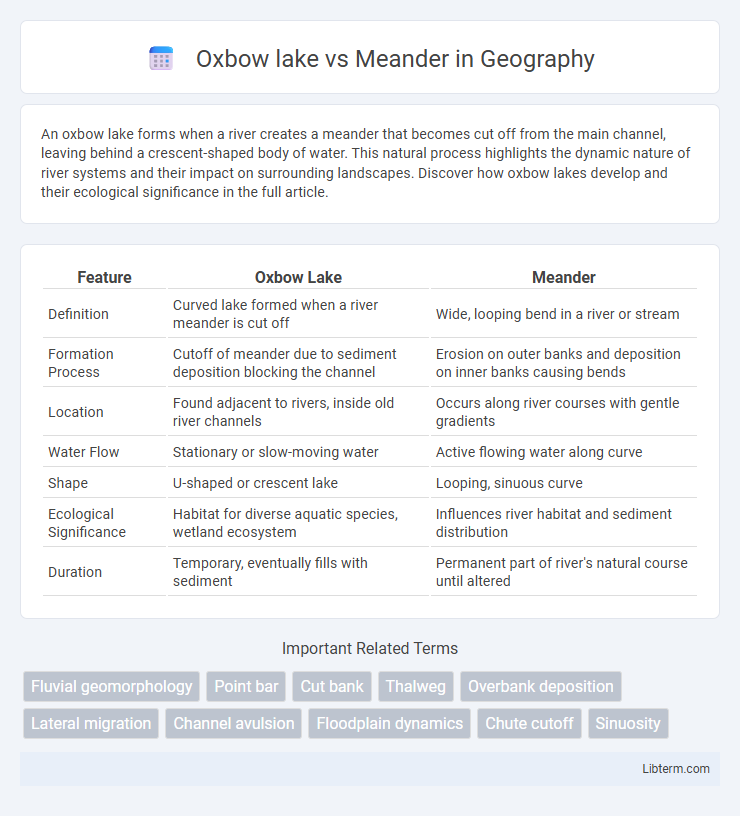An oxbow lake forms when a river creates a meander that becomes cut off from the main channel, leaving behind a crescent-shaped body of water. This natural process highlights the dynamic nature of river systems and their impact on surrounding landscapes. Discover how oxbow lakes develop and their ecological significance in the full article.
Table of Comparison
| Feature | Oxbow Lake | Meander |
|---|---|---|
| Definition | Curved lake formed when a river meander is cut off | Wide, looping bend in a river or stream |
| Formation Process | Cutoff of meander due to sediment deposition blocking the channel | Erosion on outer banks and deposition on inner banks causing bends |
| Location | Found adjacent to rivers, inside old river channels | Occurs along river courses with gentle gradients |
| Water Flow | Stationary or slow-moving water | Active flowing water along curve |
| Shape | U-shaped or crescent lake | Looping, sinuous curve |
| Ecological Significance | Habitat for diverse aquatic species, wetland ecosystem | Influences river habitat and sediment distribution |
| Duration | Temporary, eventually fills with sediment | Permanent part of river's natural course until altered |
Introduction to Oxbow Lakes and Meanders
Oxbow lakes form when a river's meander becomes cut off, creating a crescent-shaped body of water separated from the main channel. Meanders are the winding curves or bends in a river, shaped by erosion and deposition processes along the riverbank. These features highlight dynamic fluvial landscapes where hydrodynamic forces continuously reshape river courses and adjacent landforms.
Formation Processes: Oxbow Lake vs Meander
Oxbow lakes form when a river meander becomes extremely curved, causing the neck of the loop to narrow and eventually break through during high flow events, isolating the loop from the main channel. Meanders develop gradually through lateral erosion and deposition on the riverbanks, where erosion occurs on the outer banks and sediment deposition builds up on the inner banks, creating the characteristic sinuous bends. The formation of oxbow lakes is a direct result of meander evolution and cutoff processes induced by changes in water velocity and sediment transport.
Key Characteristics of Meanders
Meanders are sinuous bends in a river channel characterized by their curved shape, gradual erosion of outer banks, and deposition along inner banks, forming point bars. They develop in flatter landscapes where water flow slows, causing sediment to accumulate and shape the winding paths. Oxbow lakes form when a meander is cut off from the main channel, creating a distinct crescent-shaped body of water isolated from active river flow.
Unique Features of Oxbow Lakes
Oxbow lakes form when a river meander becomes cut off from the main channel, creating a distinct crescent-shaped waterbody isolated from the flowing river. Unlike meanders, which are active bends in a river's course transporting sediment and water, oxbow lakes typically have stagnant or slow-moving water supporting unique wetland ecosystems rich in biodiversity. These lakes serve as critical habitats for aquatic plants, fish, amphibians, and migratory birds, distinguishing them ecologically from the continually dynamic environment of meanders.
Geographical Occurrence and Examples
Oxbow lakes form in flat river plains where meanders become cut off, creating crescent-shaped isolated water bodies, commonly found in the Mississippi River basin in the United States. Meanders are sinuous bends in a river channel occurring in low-gradient, alluvial river valleys, with notable examples along the Amazon River in South America. Both features result from fluvial erosion and deposition but represent different stages of river evolution and landscape morphology.
Ecological Significance and Biodiversity
Oxbow lakes provide unique wetland habitats that support diverse aquatic plants, fish, amphibians, and bird species, contributing significantly to local biodiversity. Meanders, characterized by their dynamic river bends, create varied flow patterns and sediment deposition zones that foster rich riparian ecosystems and diverse habitats along the river corridor. Both features enhance ecological connectivity and serve as critical environments for nutrient cycling, species breeding, and wildlife refuge.
Hydrological Impact on River Systems
Oxbow lakes form when a meander is cut off from the main river channel, creating a distinct, isolated water body that influences local hydrology by reducing flow velocity and sediment transport in that segment. Meanders contribute to river system dynamics by promoting sediment deposition on the inner bends and erosion on the outer bends, shaping floodplains and enhancing habitat diversity. The transition from active meander to oxbow lake alters flood patterns, groundwater recharge, and nutrient cycling within the river basin, impacting overall aquatic ecosystem health.
Human Influence and River Management
Oxbow lakes often result from river meanders being artificially cut off through channelization or dredging to improve navigation and reduce flooding risks, demonstrating significant human influence on river morphology. River management practices such as levee construction and flow regulation disrupt natural meander dynamics, promoting oxbow formation or preventing meander migration. These interventions alter sediment deposition patterns and aquatic habitats, affecting the ecological balance and water quality within river systems.
Differences in Environmental Roles
Oxbow lakes serve as critical habitats for diverse aquatic plants and animals, promoting biodiversity by providing still water ecosystems separate from rivers. Meanders primarily influence river dynamics by shaping sediment transport, water flow patterns, and floodplain development. While meanders contribute to nutrient cycling and erosion control within river systems, oxbow lakes maintain localized wetland environments essential for water filtration and species refuge.
Summary: Comparing Oxbow Lakes and Meanders
Oxbow lakes form when a river meander becomes cut off, creating a crescent-shaped, isolated water body, whereas meanders are the winding curves or bends in a river channel. Oxbow lakes represent a mature stage in river evolution, indicating sediment deposition and channel migration, while meanders demonstrate active erosion and deposition processes shaping the river's path. Understanding the distinction between oxbow lakes and meanders provides insights into fluvial geomorphology and river dynamics.
Oxbow lake Infographic

 libterm.com
libterm.com